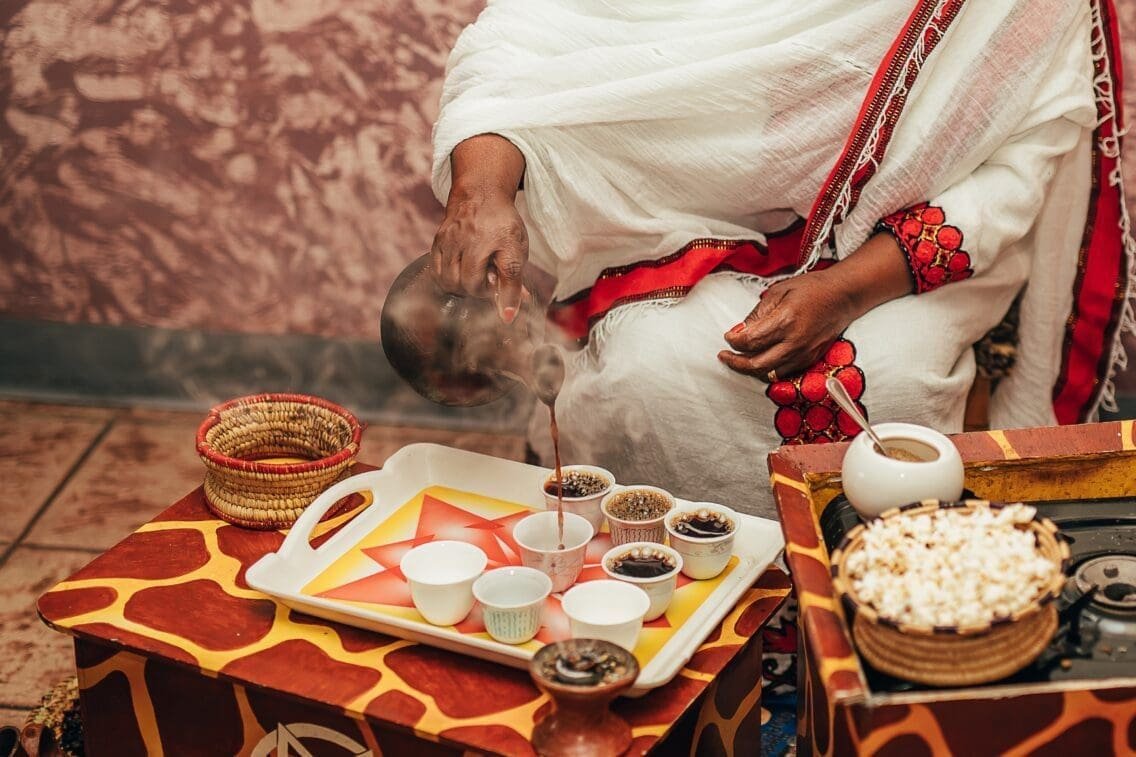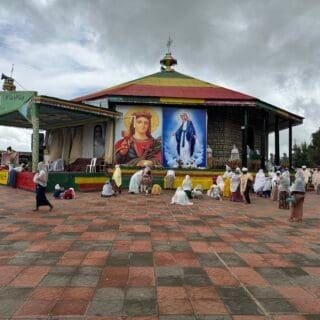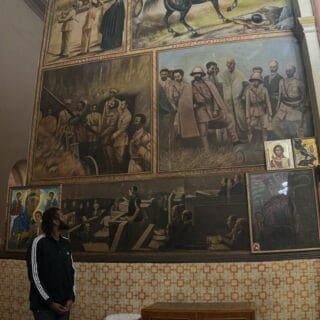History of Coffee

The coffee plant originates from the highland forests of Ethiopia. According to tradition, the very first coffee plants grew wild in the region of Kaffa — the place that gave coffee its name. One popular legend tells of a goat herder named Kaldi, who one day noticed something unusual: his goats were full of energy, happily chasing each other and bleating loudly. Curious and already feeling tired, Kaldi wondered what had caused this strange behavior. He soon realized the goats had been eating red berries from nearby bushes. Driven by curiosity, he decided to try a few himself. To his delight, his exhaustion quickly faded, replaced by a fresh burst of energy.
Kaldi felt so amazed by the berries that he filled his pockets and ran home to share them with his wife.
“They are heaven-sent,” she declared. “You must take them to the monks at the abbey!”
At the abbey, Kaldi eagerly explained to the Abbot how the berries had energized both him and his goats.
But the Abbot, clearly displeased, threw the berries into the fire, denouncing them as “the Evil One’s work.”
Within minutes, smoke rose from the berries, filling the monastery with the incredible scent of toasting beans. The other Monks quickly gathered to see what the commotion was. One Monk swiftly raked the beans from the fire and extinguished the embers by stamping on them.
The abundant smell of coffee undoubtedly agreed with the Abbot’s nose as he bought the Monk to put the currently smashed beans right into a jug and cover it with warm water to maintain their divine goodness. He after that took a sip from the container and experienced the rich and great smelling mixture that is coffee. From that day on the Monks promised to consume coffee day-to-day to maintain them awake during the long, nighttime devotions.
No one knows exactly when people first discovered coffee. However, historical evidence shows that, long before anyone brewed it as a hot drink, people ground coffee beans and combined them with other ingredients to make a kind of primitive energy bar.
Sometime between 575 and 850 AD, a nomadic mountain tribe called the Galla began mixing ground coffee with ghee. Their warriors ate these bars to boost aggression and increase stamina during battle.
ata-end=”780″ />Remarkably, people in Kaffa and Sidamo (Ethiopia) still consume these traditional bars today.
Some historians argue that coffee originated not in Ethiopia, but on the Arabian Peninsula, claiming that people began cultivating it in Yemen around 575 AD.
One Islamic legend tells of Sheikh Omar, a hermit living near the port of Mocha, who discovered wild coffee plants growing nearby. According to the tale, he boiled the berries and experienced their energizing effects firsthand. He then shared the drink with locals suffering from a mysterious illness—and miraculously cured them.
However, it’s more likely that coffee reached Yemen through Sudanese slaves. These enslaved people reportedly chewed raw coffee beans to stay energized while rowing across the Red Sea between Africa and the Arabian Peninsula.
Historical evidence suggests that people didn’t begin drinking coffee until around the 10th century. The earliest known written accounts describing coffee as a beverage appeared during this time. Two prominent Arab philosophers—Rhazes (850–922 AD) and Avicenna of Bukham (980–1037 AD)—both mentioned a drink called “bunchum,” which many scholars believe refers to coffee.
Since the Quran forbids Muslims from drinking alcohol, many turned to coffee for its comforting, uplifting, and stimulating effects. It quickly became a popular substitute for wine throughout Islamic societies.
Historians believe the first coffeehouses emerged in Mecca, Saudi Arabia. Known as Kaveh Kanes, these establishments served as public gathering places where Muslims could socialize, exchange ideas, and discuss spiritual matters.
The relationship between Islam and coffee hasn’t always been smooth. Some Muslims considered coffee an intoxicant and, therefore, forbidden under Islamic law. In 1511, the governor of Mecca, Khair Beg, spotted worshippers drinking coffee in a mosque. They were preparing for a night-long prayer vigil. Outraged, he drove them out and ordered all coffeehouses in Mecca to shut down.
This enraged pro-coffee Muslims and sparked a heated public debate. During the controversy, two corrupt Persian doctors—the Hakimani brothers, infamous for supporting whoever paid them the most—publicly condemned coffee as a harmful brew. They had personal motives for pushing the ban: coffee had become a popular remedy for melancholy, and its success meant fewer patients seeking—and paying for—their treatments.
The conflict escalated until the Sultan of Cairo, Khair Beg’s superior, stepped in. He declared that no one should ban a drink so popular in Cairo without his approval. As a result, Khair Beg soon paid the price for his defiance. In 1512, the Sultan accused him of embezzlement and sentenced him to death.
By the late 16th century, coffee use had spread widely across Arabia, North Africa, and Turkey. People believed it offered such important health benefits that they treated it as essential as bread and water. In fact, Turkish law even allowed a woman to divorce her husband if he refused to give her coffee.
Wherever Islam spread, coffee followed closely behind. As the Ottoman Empire expanded, coffee quickly reached the Eastern Mediterranean.
However, historians believe that no coffee plant grew outside Africa or Arabia until the 17th century. Exported beans from the Arabian ports of Mocha and Jidda had been parched or boiled to prevent germination.
According to legend, this changed when a pilgrim named Baba Budan smuggled fertile coffee beans out of Mecca. He strapped them to his belly and carried them back to his homeland in India. There, he successfully planted the beans in the hills of Mysore.


